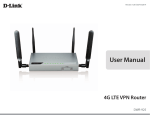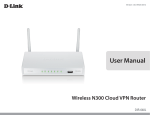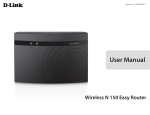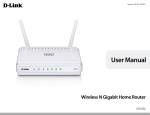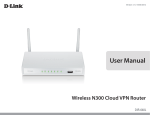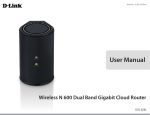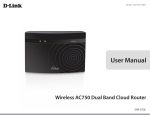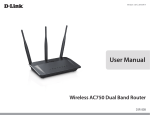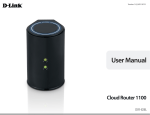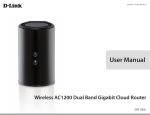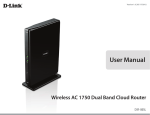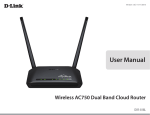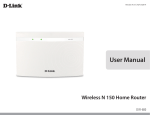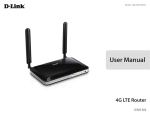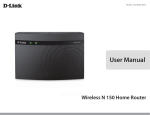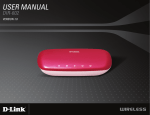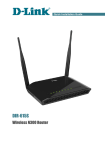Download User Manual - D-Link
Transcript
Version 1.10 | 06/24/2013 User Manual Broadband Cloud VPN Router DIR-140L Preface D-Link reserves the right to revise this publication and to make changes in the content hereof without obligation to notify any person or organization of such revisions or changes. Manual Revisions Revision Date Description 1.0 October 09, 2012 • Initial release 1.10 June 24, 2013 •First revision Trademarks D-Link and the D-Link logo are trademarks or registered trademarks of D-Link Corporation or its subsidiaries in the United States or other countries. All other company or product names mentioned herein are trademarks or registered trademarks of their respective companies. Copyright © 2013 by D-Link Corporation. All rights reserved. This publication may not be reproduced, in whole or in part, without prior expressed written permission from D-Link Corporation. D-Link DIR-140L User Manual i Table of Contents Table of Contents Preface.................................................................................. i Manual Revisions............................................................................ i Trademarks....................................................................................... i Product Overview............................................................... 1 Package Contents.......................................................................... 1 System Requirements.................................................................. 2 Introduction.................................................................................... 3 Features............................................................................................. 4 Hardware Overview...................................................................... 5 Back............................................................................................ 5 Front........................................................................................... 6 Installation.......................................................................... 7 Before you Begin............................................................................ 7 Wall-Mount Kit Installation........................................................ 8 Hardware Setup............................................................................. 9 Configuration....................................................................11 Web Setup Wizard.......................................................................11 Web-based Configuration Utility...........................................16 Internet Connection Setup......................................................17 Internet Connection Wizard.............................................17 Manual Internet Connection...........................................19 Static (assigned by ISP).................................................20 Dynamic IP (DHCP).........................................................21 PPPoE (DSL).......................................................................22 PPTP.....................................................................................23 D-Link DIR-140L User Manual L2TP.....................................................................................24 3G.........................................................................................25 Dial-Up................................................................................26 Russian PPPoE..................................................................27 Russian PPTP.....................................................................28 Russian L2TP.....................................................................29 Network Settings.........................................................................30 VPN Settings..................................................................................32 VPN Setup Wizard................................................................32 Dynamic IPSec VPN........................................................33 IPSec VPN...........................................................................34 PPTP VPN............................................................................35 L2TP VPN............................................................................37 VPN Manual Settings..........................................................39 IPSec Settings...................................................................40 PPTP/L2TP Settings........................................................42 GRE Settings.....................................................................43 IPv6...................................................................................................44 Static IPv6...............................................................................45 DHCPv6...................................................................................46 PPPoE.......................................................................................47 IPv6 over IPv4 Tunneling...................................................48 6 to 4 Tunneling....................................................................49 6rd.............................................................................................50 Link-Local Connectivity.....................................................51 Mydlink Settings..........................................................................52 ii Table of Contents Advanced..........................................................................53 Virtual Server.................................................................................53 Application Rules.........................................................................54 QoS Engine....................................................................................55 Network Filter...............................................................................57 Web Filter.......................................................................................58 Firewall Settings...........................................................................59 Routing............................................................................................61 Advanced Network.....................................................................62 IPv6 Firewall...................................................................................63 User Group.....................................................................................64 Routing............................................................................................80 VPN...................................................................................................81 IPv6...................................................................................................82 Support.............................................................................83 Troubleshooting...............................................................84 Networking Basics............................................................88 Check your IP address................................................................88 Statically Assign an IP address................................................89 Technical Specifications...................................................90 Maintenance.....................................................................65 Admin..............................................................................................65 SNMP................................................................................................66 Time..................................................................................................67 SysLog..............................................................................................68 Email Settings...............................................................................69 System.............................................................................................70 Firmware.........................................................................................71 Dynamic DNS................................................................................72 System Check................................................................................73 Schedules.......................................................................................74 Status.................................................................................75 Device Info.....................................................................................75 Log....................................................................................................76 Statistics..........................................................................................77 Active Session...............................................................................78 LAN Clients.....................................................................................79 D-Link DIR-140L User Manual iii Section 1 - Product Overview Product PackageOverview Contents DIR-140L Broadband Cloud VPN Router Ethernet Cable Power Adapter Optional Wall-Mount Kit If any of the above items are missing, please contact your reseller. Note: Using a power supply with a different voltage rating than the one included with the DIR-140L will cause damage and void the warranty for this product. D-Link DIR-140L User Manual 1 Section 1 - Product Overview System Requirements Network Requirements • An Ethernet-based Cable or DSL modem • 10/100 Ethernet Computer with the following: • Windows®, Macintosh, or Linux-based operating system • An installed Ethernet adapter Web-based Configuration Utility Requirements Browser Requirements: • Internet Explorer 8 or later • Firefox 12.0 or later • Safari 4 or later • Google Chrome 20.0 or later Windows® Users: Make sure you have the latest version of Java installed. Visit www.java.com to download the latest version. D-Link DIR-140L User Manual 2 Section 1 - Product Overview Introduction TERRIFIC VPN PERFORMANCE For optimal VPN configuration, the DIR-140L has an integrated VPN client and server to support almost any required VPN policy. This device has a hardware VPN engine to support and manage up to 25 VPN configurations. The DIR-140L can support IPSec, PPTP, L2TP, and GRE protocols in server mode and can handle pass-through traffic as well. Advanced VPN configuration options include: DES, 3DES, and AES encryption, IKE/ISAKMP key management, Main/Aggressive Negotiation modes, and VPN authentication support using the internal 10-user database. User Configurable Interface The DIR-140L features an intuitive user interface that can easily be configured and monitored via D-Link’s web-based management interface. These configuration options can be managed through Admin or Read/Write administrator rights. With these access management levels, any authorized user can easily configure or access the management interface of the DIR-140L. Use mydlink to Monitor Your Network The Broadband Cloud VPN Router is mydlink-enabled, so you can effortlessly access and view your network no matter where you are. See who is connected to your router, change settings, or block someone from using your network connection, all from any Internet connected PC, or an iOS or Android mobile device. Home users can check on their children’s web browsing habits, and business users can manage employee Internet activity, all while staying informed and in control on the go. Advanced Hardware Features The DIR-140L can be connected to a cable or DSL line to share high-speed Internet access. It also doubles as a 4-port full-duplex 10/100 switch to connect up to four Ethernet-enabled devices, and you can simply add more switches to expand your wired network. In addition, you can create a Virtual Private Network (VPN) with the DIR-140L and allow up to 25 off-site or traveling users to securely access your central network through the Internet simultaneously. TOTAL NETWORK SECURITY The DIR-140L has a host of security features to prevent unauthorized access and utilizes dual active firewalls (SPI and NAT) to prevent potential attacks from across the Internet. D-Link DIR-140L User Manual 3 Section 1 - Product Overview Features •Versatile VPN Connectivity - The DIR-140L can create secure connections easily with support for up to 25 VPN tunnels and standards including IPSec, PPTP, L2TP, and GRE tunneling •Built-In Security - The DIR-140L features a dual-active firewall that works to protect against network attacks and keep your network safe from outside threats •Cloud Management - The DIR-140L is mydlink-enabled, which helps you manage your router from anywhere.1 •Advanced Firewall Features - The web-based user interface displays a number of advanced network management features including: • Secure Multiple/Concurrent Sessions - The DIR-140L can pass through VPN sessions. It supports multiple and concurrent IPSec and PPTP sessions, so users behind the DIR-140L can securely access corporate networks. •User-friendly Setup Wizard - Through its easy-to-use web-based user interface, the DIR-140L lets you control what information is accessible to those on the network, whether from the Internet or from your company’s server. Configure your router to your specific settings within minutes. mydlink support available soon through a future firmware update. 1 D-Link DIR-140L User Manual 4 Section 1 - Product Overview Hardware Overview Back 1 2 3 5 4 6 1 COM Port 2 LAN Ports (1-4) 3 Internet Port The auto MDI/MDIX Internet port is the connection for the Ethernet cable to the cable or DSL modem. 4 Reset Button Pressing the Reset button restores the router to its original factory default settings. 5 Power Connector 6 Power Switch D-Link DIR-140L User Manual RS-232 COM port for serial port communication and legacy device connectivity. Connect 10/100 Ethernet devices such as computers, switches, and NAS. Receptor for the supplied power adapter. Turns the device on/off. 5 Section 1 - Product Overview Hardware Overview Front 1 2 1 Power LED 2 Internet LED 3 LAN LEDs (1-4) 4 USB 2.0 port D-Link DIR-140L User Manual 3 4 A solid light indicates a proper connection to the power supply. A solid light indicates connection on the Internet port. This LED blinks during data transmission. A solid light indicates a connection to an Ethernet-enabled computer on ports 1-4. This LED blinks during data transmission. Allows you to connect 3G modems. 6 Section 2 - Installation Installation This section will walk you through the installation process. Placement of the router is very important. Do not place the router in an enclosed area such as a closet, cabinet, or in an attic or garage. Before you Begin • Please configure the router with the computer that was last connected directly to your modem. • You can only use the Ethernet port on your modem. If you were using a USB connection before using the router, then you must turn off your modem, disconnect the USB cable and connect an Ethernet cable to the Internet port on the router, and then turn the modem back on. In some cases, you may need to call your ISP to change connection types (USB to Ethernet). • If you have DSL and are connecting via PPPoE, make sure you disable or uninstall any PPPoE software such as WinPoet, Broadjump, or Enternet 300 from your computer or you will not be able to connect to the Internet. D-Link DIR-140L User Manual 7 Section 2 - Installation Wall-Mount Kit Installation The wall-mount kit includes the following items: - Two 2 cm screws - Two screw anchors - One attachment plate Step 1.Align the attachment plate to your preferred position, and mark the hole positions on the wall, preferably after you locate one of the studs in the wall. Step 2.Drill holes into the wall and insert the screw anchors where there is no stud. Check that the screw anchors are securely in place. Step 3.Securely screw down the attachment plate on the wall. Wall mount hole Wall mount hole DIR-140L Step 4.Hang the router on the wall by sliding the tops of the screws through the holes on the bottom of the router and then slide to lock into position. Confirm that the router is firmly in place. D-Link DIR-140L User Manual 8 Section 2 - Installation Hardware Setup 1.Turn off and unplug your cable or DSL broadband modem. This is required. Modem 2.Unplug the Ethernet cable from your modem (or existing router if upgrading) that is connected to your computer. Plug it into the blue port labeled 1 on the back of your router. The router is now connected to your computer. DIR-140L COM POWER Computer D-Link DIR-140L User Manual 9 Section 2 - Installation 4.Plug one end of the included blue Ethernet cable that came with your router into the yellow port labeled INTERNET on the back of the router. Plug the other end of this cable into the Ethernet port on your modem. COMM POWER DIR-140L Modem 5.Reconnect the power adapter to your cable or DSL broadband modem and wait for two minutes. 6.Connect the supplied power adapter into the power port on the back of the router and then plug it into a power outlet or surge protector. Press the power button and verify that the power LED is lit. Allow 1 minute for the router to boot up. COMM POWER DIR-140L 7.If you are connecting to a Broadband service that uses a dynamic connection (not PPPoE), you may be online already. Try opening a web browser and enter a web site. If you connect, you are finished with your Internet setup. Please skip to page 13 to configure your router and use the manual setup procedure to configure your network. If you are unable to connect to the Internet, use the D-Link Setup Wizard (refer to page 15). D-Link DIR-140L User Manual 10 Section 3 - Configuration Configuration Web Setup Wizard Open your web browser and the setup wizard will automatically launch. Step 1: The Welcome screen will appear. Click Next to continue. Note: Make sure to remove any PPPoE software from your computer. The software is no longer needed and will not work through a router. Step 2: The router will automatically detect your Internet connection type. Step 3: If the router could not automatically detect your connection type, select your connection type and click Next to continue. D-Link DIR-140L User Manual 11 Section 3 - Configuration If you selected PPPoE, enter your PPPoE username and password. Click Next to continue. Note: Make sure to remove your PPPoE software from your computer. The software is no longer needed and will not work through a router. If you selected PPTP, enter your PPTP settings supplied by your ISP and your PPTP username and password. Click Next to continue. If you selected L2TP, enter your L2TP settings supplied by your ISP and your L2TP username and password. Click Next to continue. D-Link DIR-140L User Manual 12 Section 3 - Configuration If you selected Static, enter your network settings supplied by your Internet provider. Click Next to continue. Step 4: Create a new password and then click Next to continue. Step 5: Select your time zone from the drop-down menu and then click Next to continue. D-Link DIR-140L User Manual 13 Section 3 - Configuration Step 6: Setup is complete. Click Save to continue. Step 7: You may bookmark the router’s web UI by clicking OK. If you do not want to bookmark the link, click Cancel. The router will reboot. Please allow 1-2 minutes. Close your browser window and reopen it to test your Internet connection. It may take a few tries to initially connect to the Internet. Step 8: Select Yes to register your router with your existing mydlink account or select No to create a new mydlink account. Click Next. D-Link DIR-140L User Manual 14 Section 3 - Configuration Step 9: If you have an existing mydlink account, enter the required information and click Login. If you don’t have a mydlink account, enter the required registration information and click Sign Up. Step 10: A pop-up will appear, click OK. D-Link DIR-140L User Manual 15 Section 3 - Configuration Web-based Configuration Utility To access the configuration utility, open a web-browser such as Internet Explorer and enter the IP address of the router (http://192.168.0.1 or you can use http://dlinkrouter.local.). Select Admin from the drop-down menu and the password should be left empty. D-Link DIR-140L User Manual 16 Section 3 - Configuration Internet Connection Setup Use this tab to choose if you want to follow the simple steps of the Connection Setup Wizard, or if you want to set up your Internet connection manually. Internet Connection Wizard Click Next to begin the Setup Wizard. D-Link DIR-140L User Manual 17 Section 3 - Configuration STEP 1: Choose a password for your device. STEP 2: Choose the method you use to connect to the Internet, and follow the step-by-step instructions. D-Link DIR-140L User Manual 18 Section 3 - Configuration Manual Internet Connection Use this tab to choose either Static IP, DHCP, PPPoE, PPTP, Dial-Up, or L2TP to configure your Internet connection. You may need to get this information from your Internet Service Provider (ISP). D-Link DIR-140L User Manual 19 Section 3 - Configuration Static (assigned by ISP) Select Static IP address if all the Internet port’s IP information is provided to you by your ISP. You will need to enter in the IP address, subnet mask, gateway address, and DNS address(es) provided to you by your ISP. Each IP address entered in the fields must be in the appropriate IP form, which are four octets separated by a dot (x.x.x.x). The router will not accept the IP address if it is not in this format. My Internet Select Static IP to manually enter the IP settings supplied by your ISP. Connection Is: Auto-Backup: Check this box to enable wired-WAN alive if you have 3G failover. Internet host: Enter the IP address for the auto-backup host. IP Address: Enter the IP address assigned by your ISP. Subnet Mask: Enter the subnet mask assigned by your ISP. Default Gateway: Enter the gateway assigned by your ISP. DNS Servers: The DNS server information will be supplied by your ISP. MTU: Maximum Transmission Unit - you may need to change the MTU for optimal performance with your specific ISP. 1500 is the default MTU. MAC Address: The default MAC address is set to the Internet port’s physical interface MAC address on the broadband router. It is not recommended that you change the default MAC address unless required by your ISP. You can use the Clone Your PC’s MAC Address button to replace the Internet port’s MAC address with the MAC address of your Ethernet card. D-Link DIR-140L User Manual 20 Section 3 - Configuration Dynamic IP (DHCP) My Internet Select Dynamic IP (DHCP) to obtain IP address information Connection Is: automatically from your ISP. Select this option if your ISP does not give you any IP numbers to use. This option is commonly used for cable modem services. Auto-Backup: Check this box to enable wired-WAN alive if you have 3G failover. Internet host: Enter the IP address for the auto-backup host. Host Name: The host name is optional but may be required by some ISPs. Leave blank if you are not sure. Primary/Secondary Enter the primary and secondary DNS server IP addresses assigned DNS Server: by your ISP. These addresses are usually obtained automatically from your ISP. Leave at 0.0.0.0 if you did not specifically receive these from your ISP. MTU: Maximum Transmission Unit - you may need to change the MTU for optimal performance with your specific ISP. 1500 is the default MTU. MAC Address: The default MAC address is set to the Internet port’s physical interface MAC address on the broadband router. It is not recommended that you change the default MAC address unless required by your ISP. You can use the Clone Your PC’s MAC Address button to replace the Internet port’s MAC address with the MAC address of your Ethernet card. D-Link DIR-140L User Manual 21 Section 3 - Configuration PPPoE (DSL) Choose PPPoE (Point to Point Protocol over Ethernet) if your ISP uses a PPPoE connection. Your ISP will provide you with a username and password. This option is typically used for DSL services. Please be sure to remove any PPPoE software from your computer. My Internet Select PPPoE (Username/Password) from the drop-down menu. Connection Is: Auto-Backup: Check this box to enable wired-WAN alive if you have 3G failover. Internet host: Enter the IP address for the auto-backup host. Address Mode: Select Static IP if your ISP assigned you the IP address, subnet mask, gateway, and DNS server addresses. In most cases, select Dynamic. IP Address: Enter the IP address (Static PPPoE only). User Name: Enter your PPPoE user name. Password: Enter your PPPoE password and then retype the password in the next box. Service Name: Enter the ISP service name (optional). Reconnect Select either Always-on, On-Demand, or Manual. Mode: Maximum Idle Enter a maximum idle time during which the Internet connection is maintained during inactivity. To disable this feature, enable Time: auto-reconnect. DNS Addresses: Enter the primary and secondary DNS server addresses (Static PPPoE only). MTU: Maximum Transmission Unit - you may need to change the MTU for optimal performance with your specific ISP. 1492 is the default MTU. MAC Address: The default MAC address is set to the Internet port’s physical interface MAC address on the broadband router. It is not recommended that you change the default MAC address unless required by your ISP. You can use the Clone Your PC’s MAC Address button to replace the Internet port’s MAC address with the MAC address of your Ethernet card. D-Link DIR-140L User Manual 22 Section 3 - Configuration PPTP Choose PPTP if your ISP uses a PPTP connection. Your ISP will provide you with a username and password. My Internet Select PPTP from the drop-down menu. Connection Is: Address Mode: Select Static IP if your ISP assigned you the IP address, subnet mask, gateway, and DNS server addresses. In most cases, select Dynamic. PPTP IP Address: Enter the IP address for your PPTP connection. PPTP Subnet Mask: Enter your PPTP subnet mask. PPTP Gateway IP Enter the gateway IP address for your PPTP connection. Address: PPTP Server IP Enter the server IP address for your PPTP connection. Address: User Name: Enter your PPTP user name. Password: Enter your PPTP password and then retype the password in the next box. Reconnect Mode: Select either Always-on, On-Demand, or Manual. Maximum Idle Enter a maximum idle time during which the Internet connection is maintained during inactivity. To disable this feature, enable Time: auto-reconnect. DNS Addresses: Enter the primary and secondary DNS server addresses (Static PPTP only). MTU: Maximum Transmission Unit - you may need to change the MTU for optimal performance with your specific ISP. 1492 is the default MTU. MAC Address: The default MAC address is set to the Internet port’s physical interface MAC address on the broadband router. You can use the Clone Your PC’s MAC Address button to replace the Internet port’s MAC address with the MAC address of your Ethernet card. D-Link DIR-140L User Manual 23 Section 3 - Configuration L2TP Choose L2TP if your ISP uses a L2TP connection. Your ISP will provide you with a username and password. My Internet Select L2TP from the drop-down menu. Connection Is: Address Mode: Select Static IP if your ISP assigned you the IP address, subnet mask, gateway, and DNS server addresses. In most cases, select Dynamic. PPTP IP Address: Enter the IP address for your L2TP connection. PPTP Subnet Mask: Enter your L2TP subnet mask. PPTP Gateway IP Enter the gateway IP address for your L2TP connection. Address: PPTP Server IP Enter the server IP address for your L2TP connection. Address: User Name: Enter your L2TP user name. Password: Enter your L2TP password and then retype the password in the next box. Reconnect Mode: Select either Always-on, On-Demand, or Manual. Maximum Idle Enter a maximum idle time during which the Internet connection is maintained during inactivity. To disable this feature, enable Time: auto-reconnect. DNS Addresses: Enter the primary and secondary DNS server addresses (Static L2TP only). MTU: Maximum Transmission Unit - you may need to change the MTU for optimal performance with your specific ISP. 1492 is the default MTU. MAC Address: The default MAC address is set to the Internet port’s physical interface MAC address on the broadband router. You can use the Clone Your PC’s MAC Address button to replace the Internet port’s MAC address with the MAC address of your Ethernet card. D-Link DIR-140L User Manual 24 Section 3 - Configuration 3G Choose 3G if you are connection from a mobile wireless network with an ISP that uses a 3G connection. My Internet Select 3G from the drop-down menu. Connection Is: Dial-Up Profile: In most cases you can choose Auto-Detection to get a connection. Otherwise choose Manual and personalize the settings below. Country: Choose the country where you get 3G service from the drop-down menu. Telecom Choose your mobile service provider from the drop-down menu. 3G Network: Choose the type of 3G network you have from the drop-down menu. User Name: Enter your 3G network user name, this is not always required by your ISP. Password: Enter your 3G network password and then retype the password in the next box. This is also not always required by your ISP. Dialed Number: Enter the number your ISP gave you to dial for a connection. Authentication: Choose the type of authentication need to connect or use auto detection. APN: If your ISP has given you an Access Point Name to use for your connectivity, you may enter it here. Reconnect Mode: Select either Always-on, On-Demand, or Manual. Maximum Idle Enter a maximum idle time during which the Internet connection is maintained during inactivity. To disable this feature, enable Time: auto-reconnect. DNS Addresses: Enter the primary and secondary DNS server addresses. Keep Alive: To prevent inactivity from assuming a dropped connection you can select LCP Echo Request to request frequent pings to maintain communication. This is disabled by default. D-Link DIR-140L User Manual 25 Section 3 - Configuration Dial-Up Choose Dial-Up if you use a dial-up connection with your ISP to connect to the Internet. My Internet Select Dial-up Network from the drop-down menu. Connection Is: Dial-up Telephone: Enter the telephone number you use to reach your dial-up provider. Dial-up Account: Enter the account name for your dial-up service. Dial-up Password: Enter your password and then retype the password in the next box. Maximum Idle Choose the amount of minutes of inactivity before the connection is Time: dropped. Choose “0” if you want to never drop the connection. Reconnect Mode: Select either Always-on, On-Demand, or Manual. Baud Rate: Choose the speed of your modem connection from the drop-down menu. DNS Addresses: Enter the primary and secondary DNS server addresses. Assigned IP If your ISP gave you a static IP address for your connections, enter it here. Address: Extra Settings: Add any additional settings provided by your ISP here. D-Link DIR-140L User Manual 26 Section 3 - Configuration Russian PPPoE Choose Russian PPPoE (Dual Access) if your ISP uses a PPPoE connection in Russia with WAN physical access. My Internet Select Russian PPPoE (Dual Access) from the drop-down menu. Connection Is: Address Mode: Select Static IP if your ISP assigned you the IP address, subnet mask, gateway, and DNS server addresses. In most cases, select Dynamic. IP Address: Enter the IP address (Static PPPoE only). User Name: Enter your PPPoE user name. Password: Enter your PPPoE password and then retype the password in the next box. Service Name: Enter the ISP service name (optional). Reconnect Mode: Select either Always-on, On-Demand, or Manual. Maximum Idle Enter a maximum idle time during which the Internet connection is Time: maintained during inactivity. To disable this feature, enable auto-reconnect. MTU: Maximum Transmission Unit - you may need to change the MTU for optimal performance with your specific ISP. 1492 is the default MTU. MAC Address: The default MAC address is set to the Internet port’s physical interface MAC address on the broadband router. You can use the Clone Your PC’s MAC Address button to replace the Internet port’s MAC address with the MAC address of your Ethernet card. WAN Physical Select a Dynamic IP or Static IP if your WAN physical setting. Setting: IP Address Enter the IP address for your PPTP connection. Subnet Mask: Enter your PPTP subnet mask. DNS Addresses: Enter the primary and secondary DNS server addresses (Static PPPoE only). D-Link DIR-140L User Manual 27 Section 3 - Configuration Russian PPTP Choose Russian PPTP (Dual Access) if your ISP uses an PPTP connection in Russia with WAN physical access. My Internet Select Russian PPTP (Dual Access) from the drop-down menu. Connection: PPTP Server IP Enter the IP address provided by your ISP. Address: User Name: Enter your PPTP user name. Password: Enter your PPTP password and then retype the password in the next box. Reconnect Mode: Select either Always-on, On-Demand, or Manual. Maximum Idle Time: Enter a time during which the Internet connection is maintained during inactivity. To disable this feature, enable auto-reconnect. MTU: Enter the desired Maximum Transmission Unit. MAC Address: The default MAC address is set to the Internet port’s physical interface MAC address on the broadband router. It is not recommended that you change the default MAC address unless required by your ISP. You can use the Clone Your PC’s MAC Address button to replace the Internet port’s MAC address with the MAC address of your Ethernet card. Address Mode: Select Static IP if your ISP assigned you the IP address, subnet mask, gateway, and DNS server addresses. In most cases, select Dynamic. PPTP IP Address: Enter the PPTP IP address. PPTP Subnet Mask: Enter your PPTP subnet mask. PPTP Gateway IP Enter the PPTP gateway IP address. Address: DNS Addresses: Enter the primary and secondary DNS server addresses (static PPTP only). D-Link DIR-140L User Manual 28 Section 3 - Configuration Russian L2TP Choose Russian L2TP (Dual Access) if your ISP uses an L2TP connection in Russia with WAN physical access. My Internet Select Russian L2TP (Dual Access) from the drop-down menu. Connection: L2TP Server IP Enter the IP address provided by your ISP. Address: User Name: Enter your L2TP user name. Password: Enter your L2TP password and then retype the password in the next box. Reconnect Mode: Select either Always-on, On-Demand, or Manual. Maximum Idle Time: Enter a maximum idle time during which the Internet connection is maintained during inactivity. To disable this feature, enable auto-reconnect. MTU: Enter the desired Maximum Transmission Unit. MAC Address: The default MAC address is set to the Internet port’s physical interface MAC address on the broadband router. It is not recommended that you change the default MAC address unless required by your ISP. You can use the Clone Your PC’s MAC Address button to replace the Internet port’s MAC address with the MAC address of your Ethernet card. Address Mode: Select Static IP if your ISP assigned you the IP address, subnet mask, gateway, and DNS server addresses. In most cases, select Dynamic. L2TP IP Address: Enter the L2TP IP address. L2TP Subnet Mask: Enter your L2TP subnet mask. L2TP Gateway IP Enter the L2TP gateway IP address. Address: DNS Addresses: Enter the primary and secondary DNS server addresses. D-Link DIR-140L User Manual 29 Section 3 - Configuration Network Settings This section will allow you to change the local network settings of the router and to configure the DHCP settings. Router IP Address: Enter the IP address of the router. The default IP address is 192.168.0.1. Subnet Mask: Enter the subnet mask. The default subnet mask is 255.255.255.0. Device Name: Choose a name for the router. Enable DHCP Check this box to enable the DHCP server on your router. Server: Uncheck to disable this function. DHCP IP Address Enter the starting and ending IP addresses for the DHCP server’s Range: IP assignment. DHCP Lease Time: The length of time for the IP address lease. Enter the lease time in minutes. Primary WINS IP Enter your primary WINS server IP address. Address: Secondary WINS IP Enter your secondary WINS server IP address. Address: D-Link DIR-140L User Manual 30 Section 3 - Configuration Enable DHCP Check this box to add a DHCP reservations list. Reservations: Computer Name: Give an identity to the computer. IP Address: Enter the computer’s IP address. MAC Address: Enter the MAC address or Clone your PC’s MAC address. Clone Your PC’s If you want to assign an IP address to the computer you are MAC Address: currently on, click this button to populate the fields. Save: Click Save to save your entry. You must click Save Settings at the top to activate your reservations. DHCP Reservations Displays any reservation entries. Displays the host name (name of your computer or device), MAC address, and IP address. List: Enable: Check to enable/disable the reservation from the existing DHCP reservation list. Edit: Click the edit icon to make changes to the reservation entry. Delete: Click to remove the reservation from the list. D-Link DIR-140L User Manual 31 Section 3 - Configuration VPN Settings On this page you can set up advanced options for a Virtual Private Network (VPN). The DIR-140L supports both IPSec and L2TP as the Server Endpoint. IPSec (Internet Protocol Security) is a set of protocols that can provide IP security at the network layer. Use this page you can choose if you want to follow the simple steps of the VPN Setup Wizard, or if you want to set up VPN options manually. VPN Setup Wizard This tells you what to expect when you go through the wizard. To go to Step 1 (Selecting Your VPN Type), click Next. D-Link DIR-140L User Manual 32 Section 3 - Configuration Dynamic IPSec VPN STEP 1: Choose Dynamic IPSec (Internet Protocol Security) then click Next. STEP 2: Give your VPN profile a name, and click Next. STEP 3: Enter the Local Subnet/Mask and the pre-shared key for your VPN, and click Next. STEP 4: Click Next to restart the router. You have now completed the VPN Wizard Setup. D-Link DIR-140L User Manual 33 Section 3 - Configuration IPSec VPN STEP 1: Choose Dynamic IPSec (Internet Protocol Security) then click Next. STEP 2: Give your VPN profile a name, and click Next. STEP 3: Enter the remote IP/subnet/netmask, the local subnet/ netmask, and the pre-shared key for your VPN, and click Next. STEP 4: Click Next to restart the router. You have now completed the VPN Wizard Setup. D-Link DIR-140L User Manual 34 Section 3 - Configuration PPTP VPN STEP 1: Choose PPTP (Point-to-Point Tunneling Protocol) then click on Next. STEP 2: Give your VPN profile a name, and click Next. STEP 3: Choose your authentication protocol/MPPE encryption/ database and enter a username and password for your VPN, and click Next. D-Link DIR-140L User Manual 35 Section 3 - Configuration STEP 4: Enter a VPN server IP and remote IP range, and click Next. STEP 5: Click Next to restart the router. You have now completed the VPN Wizard Setup. D-Link DIR-140L User Manual 36 Section 3 - Configuration L2TP VPN STEP 1: Choose L2TP (Layer 2 Tunneling Protocol) then click Next. STEP 2: Give your VPN profile a name, and click Next. STEP 3: Choose and username and password for your VPN, and click Next. D-Link DIR-140L User Manual 37 Section 3 - Configuration STEP 4: Enter a VPN server IP and remote IP range, and click Next. STEP 4: Click Next to restart the router. You have now completed the VPN Wizard Setup. D-Link DIR-140L User Manual 38 Section 3 - Configuration VPN Manual Settings On this page you can set up advanced options for a Virtual Private Network (VPN). The DIR-140L supports both IPSec and L2TP as the Server Endpoint. IPSec (Internet Protocol Security) is a set of protocols that can provide IP security at the network layer. Add VPN Profile: Choose either IPSec or PPTP/L2TP and GRE Tunnel from the drop-down menu and click Add to begin configuring a VPN profile. VPN Profile: This list allows you to Enable established VPN profiles as well as Edit and Delete them. D-Link DIR-140L User Manual 39 Section 3 - Configuration IPSec Settings The DIR-140L supports IPSec as the Server Endpoint. IPSec (Internet Protocol Security) protocols can provide IP security at the network layer. IPSec: Check this box to enable IPSec. Name: Enter a name for your VPN tunnel. Local Subnet/ Enter the local (LAN) subnet and mask. Netmask: (ex. 192.168.0.0/24) Remote IP: Select if you will be connecting as a remote user or on a site to site basis. Remote Subnet/ Enter the remote subnet and mask. Netmask: Authentication: Enter the pre-shared key for authentication. Authentication If you choose to enable XAUTH you need to choose between XAUTH: server mode with an Authentication database, or Client mode with a user name and password. Local ID: Enter the local identification for how you appear on the network VPN when connected locally. Remote ID: Enter the local identification for how you appear on the network VPN when connected remotely. D-Link DIR-140L User Manual 40 Section 3 - Configuration Phase 1 Mode: Choose if you want to use Main or Aggressive mode. NAT-T Enable: Enable or Disable the NAT-T option. Keep Alive: Enable or Disable Keep Alive protocols. DPD: Choose whether or not to detect dead peers, then set the amount of time in seconds before disconnect of dead peers. You can also set a delay time in seconds before release. DH Group: Enable or Disable the DH Group option using the drop-down menu. IKE Proposal Use this area to Enable IKE proposals. Then determine Settings: encryption and authentication types from the drop-down menus. IKE Lifetime: Enter the amount of time in seconds that the Phase 1 keys should last. PFS Enable: Choose if you want to use Perfect Forward Secrecy. PFS is an additional security protocol. PFS DH Group: Choose a PFS DH group from the drop-down menu. IPSEC Proposal Use this area to choose the encryption and authentication List: methods for IPSec proposals by choosing from the drop-down menus. IPSec Lifetime: Enter the amount of time in seconds that the phase 2 keys should last. D-Link DIR-140L User Manual 41 Section 3 - Configuration PPTP/L2TP Settings This page allows you to set up a VPN using either PPTP or L2TP. PPTP/L2TP: Check this box to enable PPTP/L2TP settings. Name: Enter a name for your VPN. Connection Type: Select PPTP or L2TP. VPN Server IP: Enter the IP address of the VPN server. Remote IP Range: Enter the remote IP range in the boxes. Authentication Choose PAP, CHAP, or MS-CHAP v2 for your authentication. Protocol: MPPE Encryption Choose either RC4, None, 40 bit, or 128 bit to determine the strength level of your authentication. Mode: Extended If you wish to use extended authentication, choose a group from the drop-down menu. Authentication: D-Link DIR-140L User Manual 42 Section 3 - Configuration GRE Settings This page shows you the options for setting up a VPN tunnel using Generic Routing Encapsulation (GRE), which is a tunneling protocol that can encapsulate a wide variety of network layer protocols inside virtual point-to-point links over an Internet Protocol. VPN - GRE Enable: Check this box to enable GRE VPN settings. Name: Enter a name for your VPN. Tunnel IP: Select an IP address for the tunnel. Remote IP: Select an IP address to access the tunnel remotely. Remote Local Enter the remote local (LAN) subnet and mask. LAN Net/Mask: (ex. 192.168.0.0/24) Key: Enter the key for the tunnel. TTL: Enter the time to live for packets delivered. D-Link DIR-140L User Manual 43 Section 3 - Configuration IPv6 There are several connection types to choose from: Static IPv6, DHCPv6, PPPoE, IPv6 in IPv4 Tunnel, 6to4, 6rd, and Link-local. If you are unsure of your connection method, please contact your IPv6 ISP. Choose your IPv6 connection method from the drop-down menu under the IPv6 Connection Type. Note: If using the PPPoE option, you will need to ensure that any PPPoE client software on your computers has been removed or disabled. D-Link DIR-140L User Manual 44 Section 3 - Configuration Static IPv6 IPv6 Connection: Select Static IPv6 from the drop-down menu. IPv6 Address Settings: Enter the IPv6 address settings supplied by your Internet provider (ISP). Subnet Prefix Length: Enter the provided IPv6 subnet prefix length. Default Gateway: Enter the provided IPv6 gateway. DNS Addresses: Enter the primary and secondary IPv6 DNS addresses. LAN IPv6 Address: Enter the LAN (local) IPv6 address for the router. LAN IPv6 Link-Local Displays the router’s LAN link-local address. Address: Enable Check to enable the autoconfiguration feature. Autoconfiguration: Autoconfiguration Type: Select Stateful (DHCPv6) or SLAAC+Stateless DHCPv6 autoconfiguration. Router Advertisement Enter the IPv6 address lifetime (in seconds). Lifetime: DS-Lite Enable: Check this box to enable DS-Lite. DS-Lite Configuration: Select DS-Lite DHCPv6 or Manual Configuration for DS-Lite. AFTR IPv6 Address: Enter your AFTR IPv6 address for DS-Lite. This is a host IP address provided by your ISP. D-Link DIR-140L User Manual 45 Section 3 - Configuration DHCPv6 IPv6 Connection: Select Autoconfiguration (Stateless/DHCPv6) from the drop-down menu. IPv6 DNS Settings: Selec t either Obtain DNS ser ver address automatically or Use the following DNS Address. Primary/Secondary DNS Enter the primary and secondary DNS server Address: addresses. Enable DHCP-PD Check to enable DHCP-PD. LAN IPv6 Address: Enter the LAN (local) IPv6 address for the router. LAN IPv6 Link-Local Displays the router’s LAN link-local address. Address: Enable Check to enable the autoconfiguration feature. Autoconfiguration: Autoconfiguration Type: Select Stateful (DHCPv6) or SLAAC+Stateless DHCPv6 autoconfiguration. Router Advertisement Enter the IPv6 address lifetime (in seconds). Lifetime: DS-Lite Enable: Check this box to enable DS-Lite. DS-Lite Configuration: Select DS-Lite DHCPv6 or Manual Configuration for DS-Lite. AFTR IPv6 Address: Enter your AFTR IPv6 address for DS-Lite. This is a host IP address provided by your ISP. D-Link DIR-140L User Manual 46 Section 3 - Configuration PPPoE IPv6 Connection: Select PPPoE from the drop-down menu. User Name: Enter your PPPoE user name. Password: Enter your PPPoE password and then retype the password in the next box. Service Name: Enter the ISP service name (optional). MTU: Maximum Transmission Unit - you may need to change the MTU for optimal performance with your specific ISP. 1492 is the default MTU. IPv6 DNS Settings: S elec t either Obtain DNS ser ver address automatically or Use the following DNS Address. Primary/Secondary DNS Enter the primary and secondary DNS server Address: addresses. Enable DHCP-PD Check to enable DHCP-PD. LAN IPv6 Address: Enter the LAN (local) IPv6 address for the router. LAN Link-Local Address: Displays the router’s LAN link-local address. Enable Check to enable the autoconfiguration feature. Autoconfiguration: Autoconfiguration Type: Select Stateful (DHCPv6) or SLAAC+Stateless DHCPv6 autoconfiguration. Router Advertisement Enter the IPv6 address lifetime (in seconds). Lifetime: D-Link DIR-140L User Manual 47 Section 3 - Configuration IPv6 over IPv4 Tunneling IPv6 Connection: Select IPv6 over IPv4 Tunnel from the drop-down menu. Remote IPv4 Address: Enter the remote IPv4 address supplied by your Internet Service Provider (ISP). Local IPv4 Address: Enter the local IPv4 address. Local IPv6 Address: Enter the local IPv6 address. IPv6 DNS Settings: S elec t either Obtain DNS ser ver address automatically or Use the following DNS Address. Primary/Secondary DNS Enter the primary and secondary DNS server Address: addresses. LAN IPv6 Address: Enter the LAN (local) IPv6 address for the router. LAN Link-Local Address: Displays the router’s LAN link-local address. Enable Check to enable the autoconfiguration feature. Autoconfiguration: Autoconfiguration Type: Select Stateful (DHCPv6) or SLAAC+Stateless DHCPv6 autoconfiguration. Router Advertisement Enter the IPv6 address lifetime (in seconds). Lifetime: D-Link DIR-140L User Manual 48 Section 3 - Configuration 6 to 4 Tunneling IPv6 Connection: Select 6 to 4 from the drop-down menu. 6 to 4 Settings: Enter the IPv6 settings supplied by your Internet provider (ISP). Primary/Secondary Enter the primary and secondary DNS server addresses. DNS Address: LAN IPv6 Address: Displays the LAN (local) IPv6 address for the router. LAN Link-Local Displays the router’s LAN link-local address. Address: Enable Check to enable the autoconfiguration feature. Autoconfiguration: Autoconfiguration Select Stateful (DHCPv6) or SLAAC+Stateless Type: DHCPv6 autoconfiguration. Router Advertisement Enter the IPv6 address lifetime (in seconds). Lifetime: D-Link DIR-140L User Manual 49 Section 3 - Configuration 6rd IPv6 Connection: Select 6rd from the drop-down menu. Remote IPv4 Address: Enter the IPv4 (remote) address here. IPv4 Mask Length: Enter the mask length of the IPv4 address. Remote Prefix: Enter the remote prefix of the IPv4 address. Prefix Length: Enter the length of the remote prefix. Primary/Secondary DNS Enter the DNS server addresses. Addresses: LAN IPv6 Address: Displays the LAN (local) IPv6 address for the router. LAN Link-Local Address: Displays the router’s LAN link-local address. Enable Check to enable the autoconfiguration feature. Autoconfiguration: Autoconfiguration Type: Select Stateful (DHCPv6) or Stateless autoconfiguration. Router Advertisement Enter the IPv6 address lifetime (in seconds). Lifetime: D-Link DIR-140L User Manual 50 Section 3 - Configuration Link-Local Connectivity IPv6 Connection: Select Link-Local Only from the drop-down menu. LAN IPv6 Address Displays the IPv6 address of the router. Settings: D-Link DIR-140L User Manual 51 Section 3 - Configuration Mydlink Settings Setting and registering your router with mydlink will allow you to use its mydlink cloud services features, including online access and management of your router through the mydlink portal website. Click on Register mydlink Service to proceed with the wizard as shown on page 14. D-Link DIR-140L User Manual 52 Section 4 - Advanced Advanced Virtual Server This will allow you to open a single port. If you would like to open a range of ports, refer to the next page. To enable the virtual server rule, be sure to check the box for each rule and click Save Settings. Name: Enter a name for the rule or select an application from the drop-down menu. Select an application and click << to populate the fields. IP Address: Enter the IP address of the computer on your local network that you want to allow the incoming service to. If your computer is receiving an IP address automatically from the router (DHCP), you computer will be listed in the “Computer Name” drop-down menu. Select your computer and click. Private Port/ Enter the port that you want to open under Private Port Public Port: and Public Port. The private and public ports are usually the same. The public port is the port seen from the Internet side, and the private port is the port being used by the application on the computer within your local network. Protocol Type: Select TCP, UDP, or Both from the drop-down menu. Schedule: The schedule of time when the virtual server rule will be enabled. The schedule may be set to Always, which will allow the particular service to always be enabled. You can create your own times in the Maintenance > Schedules section. D-Link DIR-140L User Manual 53 Section 4 - Advanced Application Rules Some applications require multiple connections, such as Internet gaming, video conferencing, Internet telephony and others. These applications have difficulties working through NAT (Network Address Translation). Special Applications makes some of these applications work with the DIR-140L. If you need to run applications that require multiple connections, specify the port normally associated with an application in the “Trigger Port” field, select the protocol type as TCP or UDP, then enter the firewall (public) ports associated with the trigger port to open them for inbound traffic. To enable the rvule, be sure to check the box for each rule and click Save Settings. Name: Enter a name for the rule. You may select a pre-defined application from the drop-down menu and click << to populate the fields. Trigger: This is the port used to trigger the application. It can be either a single port or a range of ports. Use ‘-’ for a range and commas for multiple ports. Firewall: This is the port number on the Internet side that will be used to access the application. You may define a single port or a range of ports. You can use a comma to add multiple ports or port ranges. Traffic Type: Select the protocol of the firewall port (TCP, UDP, or Both). Schedule: The schedule of time when the application rule will be enabled. The schedule may be set to Always, which will allow the particular service to always be enabled. You can create your own times in the Maintenance > Schedules section. D-Link DIR-140L User Manual 54 Section 4 - Advanced QoS Engine The QoS Engine option helps improve your Internet performance by prioritizing applications. By default the QoS Engine settings are disabled and application priority is not classified automatically. Enable QoS This option is disabled by default. Enable this option for Engine: better performance and experience with online games and other interactive applications, such as VoIP. Upstream The speed at which data can be transferred from the Bandwidth: router to your ISP. This is determined by your ISP. ISPs often transfer as a download/upload speed pair. For example, 1.5 Mbits/284 Kbits. Using this example, you would enter 284. Alternatively you can test your uplink speed with a service such as speedtest.net. QoS Engine Rules: A QoS engine rule identifies a specific message flow and assigns a priority to that flow. For most applications, automatic classification will be adequate, and specific QoS engine rules will not be required. The QoS Engine supports overlaps between rules, where more than one rule can match for a specific message flow. If more than one rule is found to match the rule with the highest priority will be used. Local IP: The rule applies to a flow of messages whose LAN-side IP address falls within the range set here. Local Ports: The rule applies to a flow of messages whose LAN-side port number is within the range set here. Remote IP: The rule applies to a flow of messages whose WAN-side IP address falls within the range set here. Remote Ports: The rule applies to a flow of messages whose WAN-side port number is within the range set here. D-Link DIR-140L User Manual 55 Section 4 - Advanced Priority: The priority of the message flow is entered here - 1 receives the highest priority (most urgent) and 255 receives the lowest priority (least urgent). Schedule: Choose a schedule for the QoS rule. D-Link DIR-140L User Manual 56 Section 4 - Advanced Network Filter Use MAC (Media Access Control) Filters to allow or deny LAN (Local Area Network) computers by their MAC addresses from accessing the network. You can either manually add a MAC address or select the MAC address from the list of clients that are currently connected to the broadband router. Configure MAC Select Turn MAC Filtering Off, Allow MAC addresses listed Filtering: below, or Deny MAC addresses listed below from the dropdown menu. MAC Address: Enter the MAC address you would like to filter. To find the MAC address on a computer, please refer to the Networking Basics section in this manual. DHCP Client: Select a DHCP client from the drop-down menu and click << to copy that MAC address. Clear: Click to remove the MAC address. D-Link DIR-140L User Manual 57 Section 4 - Advanced Web Filter Website Filters are used to allow you to set up a list of web sites that can be viewed by multiple users through the network. To use this feature select to Allow or Deny, enter the domain or website and click Save Settings. You must also select Apply Web Filter under the Access Control section. URL Filtering: Enable URL filtering by checking this box. Checkbox: Check to enable or disable a rule. URL: Enter the keywords or URLs that you want to allow or block. Click Save Settings. Schedule: Choose a schedule for the rule. D-Link DIR-140L User Manual 58 Section 4 - Advanced Firewall Settings A firewall protects your network from the outside world. The DIR-140L offers firewall type functionality. The SPI feature helps prevent cyber attacks. Sometimes you may want a computer exposed to the outside world for certain types of applications. If you choose to expose a computer, you can enable DMZ. DMZ is short for Demilitarized Zone. This option will expose the chosen computer completely to the outside world. Enable SPI: Check to enable Stateful Packet Inspection (SPI) to allow packets from known active connections while rejecting all others. Enable Anti-Spoof Check to automatically check the origins of packets Checking: against a blacklist of known spoofers. Enable DMZ: If an application has trouble working from behind the router, you can expose one computer to the Internet and run the application on that computer. Note: Placing a computer in the DMZ may expose that computer to a variety of security risks. Use of this option is only recommended as a last resort. DMZ IP Address: Specify the IP address of the computer on the LAN that you want to have unrestricted Internet communication. If this computer obtains it’s IP address automatically using DHCP, be sure to make a static reservation on the Setup > Network Settings page so that the IP address of the DMZ machine does not change. Name: Enter a name to identify the firewall rule. Action: Choose whether to Allow or Deny all of the rules listed below. D-Link DIR-140L User Manual 59 Section 4 - Advanced Schedule: Use the drop-down menu to select the time schedule that the IPv6 firewall rule will be enabled for. The schedule may be set to Always, which will allow the particular service to always be enabled. You can create your own schedules in the Maintenance > Schedules section. Source: Use the Source drop-down menu to specify the interface that connects to the source addresses of the firewall rule. Interface Choose if the rule applies to a LAN or a WAN interface for the IP addresses in the rule. IP Address Range: Enter the source IP address range. Destination: Use the Destination drop-down menu to specify the interface that connects to the destination IP addresses of the firewall rule. Protocol: Select the protocol of the firewall port (All, TCP, UDP, or ICMP). Port Range: Enter the first port of the range that will be used for the firewall rule in the first box and enter the last port in the field in the second box. New Schedule: Click this button to create a new schedule. D-Link DIR-140L User Manual 60 Section 4 - Advanced Routing The Routing option is an advanced method of customizing specific routes of data through your network. Name: Enter a name for your route. Destination IP: Enter the IP address of packets that will take this route. Netmask: Enter the netmask of the route, please note that the octets must match your destination IP address. Gateway: Enter your next hop gateway to be taken if this route is used. Metric: The route metric is a value from 1 to 16 that indicates the cost of using this route. A value 1 is the lowest cost and 15 is the highest cost. Interface: Select the interface that the IP packet must use to transit out of the router when this route is used. D-Link DIR-140L User Manual 61 Section 4 - Advanced Advanced Network The Advanced Network Settings page offers additional feature options for power users. Enable UPnP: To use the Universal Plug and Play (UPnP™) feature click on Enabled. UPnP provides compatibility with networking equipment, software and peripherals. Enable WAN Ping Checking the box will allow the DIR-140L to respond Respond: to pings. Unchecking the box may provide some extra security from hackers. WAN Port Speed: Choose your WAN port speed from the drop-down menu. Enable Multicast Check the box to allow multicast traffic to pass through Streams: the router from the Internet. D-Link DIR-140L User Manual 62 Section 4 - Advanced IPv6 Firewall The IPv6 Firewall feature allows you to configure which kind of IPv6 traffic is allowed to pass through the device. The IPv6 Firewall functions in a similar way to the IP Filters feature. Enable IPv6 Simple Check the box to enable the IPv6 firewall simple security. Security: Configure IPv6 Select an action from the drop-down menu. Firewall: Name: Enter a name to identify the IPv6 firewall rule. Schedule: Use the drop-down menu to select the time schedule that the IPv6 Firewall Rule will be enabled on. The schedule may be set to Always, which will allow the particular service to always be enabled. You can create your own times in the Maintenance > Schedules section. Source: Use the Source drop-down menu to specify the interface that connects to the source IPv6 addresses of the firewall rule. IP Address Range: Enter the source IPv6 address range in the adjacent IP Address Range field. Destination: Use the Destination drop-down menu to specify the interface that connects to the destination IP addresses of the firewall rule. Protocol: Select the protocol of the firewall port (All, TCP, UDP, or ICMP). Enter the first port of the range that will be used for the firewall rule in the first box and enter the last port in the field in the second box. D-Link DIR-140L User Manual 63 Section 4 - Advanced User Group The User Group feature allows you to select an authentication database to store a group of user settings User Settings: Here you will find a list of Authentication databases you have created. Authentication Choose a database from the drop-down menu and choose database: Edit to make changes. D-Link DIR-140L User Manual 64 Section 5 - Maintenance Maintenance Admin This page will allow you to change the Administrator and User passwords. You can also enable Remote Management. There are two accounts that can access the management interface through the web browser. The accounts are admin and user. Admin has read/write access while user has read-only access. User can only view the settings but cannot make any changes. Only the admin account has the ability to change both admin and user account passwords. Admin Password: Enter a new password for the Administrator Login Name. Type it again in the next box. Enable Graphical Enables a challenge-response test to require users to type Authentication: letters or numbers from a distorted image displayed on the screen to prevent online hackers and unauthorized users from gaining access to your router’s network settings. Enable Remote Remote management allows the DIR-140L to be configured Management: from the Internet by a web browser. A username/password is still required to access the web management interface. IP Allowed to Enter the IP address used to access the DIR-140L. Access: Remote Admin Enter the port number used to access the DIR-140L is used Port: in the URL. Example: http://x.x.x.x:8080 where x.x.x.x is the Internet IP address of the DIR-140L and 8080 is the port used for the web management interface. D-Link DIR-140L User Manual 65 Section 5 - Maintenance SNMP The DIR-140L allows you to use the Simple Network Management Protocol for easy management of your network. SNMP Local: Enable this option to allow local SNMP management. SNMP Remote: Enable this option to allow remote SNMP management. Get Community: Enter a name for the read community of your SNMP server. Set Community: Enter a name for the write community of your SNMP server. IP1-4: Set up to four IP addresses to be managed here. SNMP Variation: Choose the version of SNMP to be used by your server: V1 or V2c. WAN Access IP Enter the IP address used for WAN access here. Address: D-Link DIR-140L User Manual 66 Section 5 - Maintenance Time The Time Configuration option allows you to configure, update, and maintain the correct time on the internal system clock. From this section you can set the time zone that you are in and set the time server. Daylight saving can also be configured to automatically adjust the time when needed. Current Router Displays the current date and time of the router. Time: Time Zone: Select your time zone from the drop-down menu. Enable Daylight To select daylight saving time manually, select enabled or Saving: disabled, and enter a start date and an end date for daylight saving time. Daylight Saving If daylight saving is enabled, you may specify the date it Dates: begins and ends. Enable NTP Server: NTP is short for Network Time Protocol. A NTP server will sync the time and date with your router. This will only connect to a server on the Internet, not a local server. Check the box to enable this feature. NTP Server Used: Enter the IP address of an NTP server or select one from the drop-down menu. Date And Time: To manually input the time, enter the values in these fields for the year, month, day, hour, minute, and second and then click Set Time. You can also click Copy Your Computer’s Time Settings to sync the date and time with the computer you are currently on. D-Link DIR-140L User Manual 67 Section 5 - Maintenance SysLog The broadband router keeps a running log of events and activities occurring on the router. You may send these logs to a SysLog server on your network. Save Log File To Click the Save button to save a local copy of the Log file Local Drive: on your PC. Enable Logging to Check this box to send the router logs to a SysLog server. SysLog Server: SysLog Server IP The address of the SysLog server that will be used to send Address: the logs. You may also select your computer from the dropdown menu (only if receiving an IP address from the router via DHCP). D-Link DIR-140L User Manual 68 Section 3 - Configuration Email Settings This section allows you to setup your email settings so that the router can send notifications and logs to your specified account. Enable Email When this option is enabled, router activity logs are emailed Notification: to a designated email address. To Email Address: Enter the email address where you want the email sent. Click the Send Email Now button to test. Email Subject: Enter a preset email subject. SMTP Server/IP Enter the SMTP server address for sending email. Address: SMTP Server Port: Enter the SMTP port used on the server. Enable Check this box if your SMTP server requires authentication. Authentication: Account Name: Enter your account for sending email. Password: Enter the password associated with the account. Re-type the password in the verify password field. On Log Full: When this option is selected, logs will be sent via email to your account when the log is full. On Schedule: Selecting this option will send the logs via email according to schedule. Schedule: This option is enabled when On Schedule is selected. You can select a schedule from the list of defined schedules. To create a schedule, go to Maintenance > Schedules. D-Link DIR-140L User Manual 69 Section 5 - Maintenance System This section allows you to manage the router’s configuration settings, reboot the router, and restore the router to the factory default settings. Restoring the unit to the factory default settings will erase all settings, including any rules that you’ve created. Save Settings to Use this option to save the current router configuration settings Local Hard Drive: to a file on the hard disk of the computer you are using. First, click the Save button. A file dialog will appear, allowing you to select a location and file name for the settings. Load Settings Use this option to load previously saved router configuration from Local Hard settings. First, use the Browse option to find a previously Drive: saved file of configuration settings. Then, click the Restore Configuration from File button to transfer those settings to the router. Restore to This option will restore all configuration settings back to the Factory Default settings that were in effect at the time the router was shipped Settings: from the factory. Any settings that have not been saved will be lost, including any rules that you have created. If you want to save the current router configuration settings, use the Save button above. Reboot Device: Click to reboot the router. D-Link DIR-140L User Manual 70 Section 5 - Maintenance Firmware You can upgrade the firmware of the router here. Make sure the firmware you want to use is on the local hard drive of the computer you are using.Please check the D-Link support website for firmware updates at http://support.dlink.com. You can download firmware upgrades to your hard drive from this site. Check Now: Click Check Now to check for new firmware and language pack versions online. Browse File: After you have downloaded the new firmware, click Browse File to locate the firmware update on your hard drive. Upgrade: Click Upgrade to complete the firmware upgrade. Upload File: After you have downloaded the new language pack, click Browse File to locate the language pack file on your hard drive. Upgrade: Click Upgrade to complete the language pack upgrade. Remove: Click Remove to delete an installed language pack. D-Link DIR-140L User Manual 71 Section 5 - Maintenance Dynamic DNS The DDNS feature allows you to host a server (Web, FTP, game server, etc…) using a domain name that you have purchased (www.whateveryournameis.com) with your dynamically assigned IP address. Most broadband Internet Service Providers assign dynamic (changing) IP addresses. Using a DDNS service provider, your friends can enter in your domain name to connect to your server no matter what your IP address is. Enable Dynamic Dynamic Domain Name System is a method of keeping a DNS: domain name linked to a changing IP address. Check the box to enable DDNS. Server Address: Select your DDNS provider from the drop-down menu or enter the DDNS server address. Host Name: Enter the host name that you registered with your DDNS service provider. Username or Key: Enter the username or key for your DDNS account. Password or Key: Enter the password or key for your DDNS account. Verify Password or Re-type the password or key to verify. Key: D-Link DIR-140L User Manual 72 Section 5 - Maintenance System Check Host Name or IP The Ping Test is used to send ping packets to test if a Address: computer is on the Internet. Enter the IP address that you wish to ping and click Ping. Ping Result: The results of your ping attempts will be displayed here. D-Link DIR-140L User Manual 73 Section 5 - Maintenance Schedules Schedules can be created for use with enforcing rules. For example, if you want to restrict web access to Mon-Fri from 3pm to 8pm, you could create a schedule selecting Mon, Tue, Wed, Thu, and Fri and enter a start time of 3pm and end time of 8pm. Name: Enter a name for your new schedule. Days: Select a day, a range of days, or All Week to include every day. Time Format: Choose a 24 hour or 12 hour clock style. Start Time: Enter a start time for your schedule. End Time: Enter an end time for your schedule. Schedule Rules The list of schedules will be listed here. Click the Edit icon List: to make changes or click the Delete icon to remove the schedule. D-Link DIR-140L User Manual 74 Section 6 - Status Status Device Info This page displays the current information for the DIR-140L. It will display the LAN and WAN (Internet) information. If your Internet connection is set up for a Dynamic IP address then a Release button and a Renew button will be displayed. Use Release to drop your DHCP IP address and use Renew to request a new one. If your Internet connection is set up for PPPoE, a Connect button and a Disconnect button will be displayed. Use Disconnect to drop the PPPoE connection and use Connect to establish the PPPoE connection. General: Displays the router’s time and firmware version. WAN: Displays the MAC address and the public IP settings. LAN: Displays the MAC address and the private (local) IP settings for the router. LAN Computers: Displays computers and devices that are connected to the router via Ethernet and that are receiving an IP address assigned by the router (DHCP). D-Link DIR-140L User Manual 75 Section 6 - Status Log The router automatically logs (records) events of possible interest in its internal memory. If there isn’t enough internal memory for all events, logs of older events are deleted but logs of the latest events are retained. The Logs option allows you to view the router logs. You can define what types of events you want to view and the level of the events to view. This router also has external Syslog server support so you can send the log files to a computer on your network that is running a Syslog utility. Refresh: Updates the log details on the screen so it displays any recent activity. Clear Logs: Clears all of the log contents. D-Link DIR-140L User Manual 76 Section 6 - Status Statistics The screen below displays the Traffic Statistics. Here you can view the amount of packets that pass through the DIR-140L on both the WAN and LAN ports. The traffic counter will reset if the device is rebooted. D-Link DIR-140L User Manual 77 Section 6 - Status Active Session The Active Session page displays full details of active Internet sessions through your router. An Internet session is a conversation between a program or application on a LAN-side computer and a program or application on a WAN-side computer. Use the buttons to navigate through the pages. D-Link DIR-140L User Manual 78 Section 6 - Status LAN Clients This page will list the LAN clients currently connected to your network. D-Link DIR-140L User Manual 79 Section 6 - Status Routing This page will display your current routing table. D-Link DIR-140L User Manual 80 Section 6 - Status VPN This page is where the router displays information on the current VPN tunnels. D-Link DIR-140L User Manual 81 Section 6 - Status IPv6 The IPv6 page displays a summary of the router’s IPv6 settings and lists the IPv6 address and host name of any IPv6 clients. D-Link DIR-140L User Manual 82 Section 7 - Support Support Click these links to get further instructions when configuring your DIR-140L Broadband Cloud VPN Router. D-Link DIR-140L User Manual 83 Section 9 - Troubleshooting Troubleshooting This chapter provides solutions to problems that can occur during the installation and operation of the DIR-140L. Read the following descriptions if you are having problems. The examples below are illustrated in Windows® XP. If you have a different operating system, the screenshots on your computer will look similar to the following examples. 1. Why can’t I access the web-based configuration utility? When entering the IP address of the D-Link router (192.168.0.1 for example), you are not connecting to a website nor do you have to be connected to the Internet. The device has the utility built-in to a ROM chip in the device itself. Your computer must be on the same IP subnet to connect to the web-based utility. • Make sure you have an updated Java-enabled web browser. We recommend the following: -Microsoft Internet Explorer® 8.0 and higher -Mozilla Firefox 12.0 and higher -Google™ Chrome 20.0 and higher -Apple Safari 4.0 and higher • Verify physical connectivity by checking for solid link lights on the device. If you do not get a solid link light, try using a different cable or connect to a different port on the device if possible. If the computer is turned off, the link light may not be on. • Disable any Internet security software running on the computer. Software firewalls such as BlackICE/ZoneAlarm, Black Ice, Sygate, Norton Personal Firewall, and Windows® XP firewall may block access to the configuration pages. Check the help files included with your firewall software for more information on disabling or configuring it. D-Link DIR-140L User Manual 84 Section 9 - Troubleshooting • Configure your Internet settings: • Go to Start > Settings > Control Panel. Double-click the Internet Options Icon. From the Security tab, click the button to restore the settings to their defaults. • Click the Connection tab and set the dial-up option to Never Dial a Connection. Click the LAN Settings button. Make sure nothing is checked. Click OK. • Go to the Advanced tab and click the button to restore these settings to their defaults. Click OK three times. • Close your web browser (if open) and open it. • Access the web management. Open your web browser and enter the IP address of your D-Link router in the address bar. This should open the login page for your web management. • If you still cannot access the configuration, unplug the power to the router for 10 seconds and plug back in. Wait about 30 seconds and try accessing the configuration. If you have multiple computers, try connecting using a different computer. 2. What can I do if I forgot my password? If you forgot your password, you must reset your router. Unfortunately this process will change all your settings back to the factory defaults. To reset the router, locate the reset button (hole) on the rear panel of the unit. With the router powered on, use a paperclip to hold the button down for 10 seconds. Release the button and the router will go through its reboot process. Wait about 30 seconds to access the router. The default IP address is 192.168.0.1. When logging in, the username is admin and the password is should be left empty. D-Link DIR-140L User Manual 85 Section 9 - Troubleshooting 3. Why can’t I connect to certain sites or send and receive emails when connecting through my router? If you are having a problem sending or receiving email, or connecting to secure sites such as eBay, banking sites, and Hotmail, we suggest lowering the MTU in increments of ten (Ex. 1492, 1482, 1472, etc). To find the proper MTU Size, you’ll have to do a special ping of the destination you’re trying to go to. A destination could be another computer, or a URL. • Click on Start and then click Run. • Windows® 95, 98, and Me users type in command (Windows® NT, 2000, XP, Vista®, and 7 users type in cmd) and press Enter (or click OK). • Once the window opens, you’ll need to do a special ping. Use the following syntax: ping [url] [-f] [-l] [MTU value] Example: ping yahoo.com -f -l 1472 D-Link DIR-140L User Manual 86 Section 9 - Troubleshooting You should start at 1472 and work your way down by 10 each time. Once you get a reply, go up by 2 until you get a fragmented packet. Take that value and add 28 to the value to account for the various TCP/IP headers. For example, lets say that 1452 was the proper value, the actual MTU size would be 1480, which is the optimum for the network we’re working with (1452+28=1480). Once you find your MTU, you can now configure your router with the proper MTU size. To change the MTU rate on your router follow the steps below: • Open your browser, enter the IP address of your router (http://192.168.0.1) and click OK. • Enter your username (admin) and password (should be left empty). Click OK to enter the web configuration page for the device. • Click on Setup and then click Manual Configure. D-Link DIR-140L User Manual 87 Appendix B - Networking Basics Networking Basics Check your IP address After you install your new D-Link adapter, by default, the TCP/IP settings should be set to obtain an IP address from a DHCP server automatically. To verify your IP address, please follow the steps below. Click on Start > Run. In the run box type cmd and click OK. (Windows® 7/Vista® users type cmd in the Start Search box.) At the prompt, type ipconfig and press Enter. This will display the IP address, subnet mask, and the default gateway of your adapter. If the address is 0.0.0.0, check your adapter installation, security settings, and the settings on your router. Some firewall software programs may block a DHCP request on newly installed adapters. D-Link DIR-140L User Manual 88 Appendix B - Networking Basics Statically Assign an IP address If you are not using a DHCP capable gateway/router, or you need to assign a static IP address, please follow the steps below: Step 1 Windows® 7 - Windows Vista® - Windows® XP - Windows® 2000 - Click on Start > Control Panel > Network and Internet > Network and Sharing Center. Click on Start > Control Panel > Network and Internet > Network and Sharing Center > Manage Network Connections. Click on Start > Control Panel > Network Connections. From the desktop, right-click My Network Places > Properties. Step 2 Right-click on the Local Area Connection which represents your network adapter and select Properties. Step 3 Highlight Internet Protocol (TCP/IP) and click Properties. Step 4 Click Use the following IP address and enter an IP address that is on the same subnet as your network or the LAN IP address on your router. Example: The router’s LAN IP address is 192.168.0.1, make your IP address 192.168.0.X where X is a number between 2 and 99. Make sure that the number you choose is not in use on the network. Set the default gateway the same as the LAN IP address of your router (I.E. 192.168.0.1). Set Primary DNS the same as the LAN IP address of your router (192.168.0.1). The Secondary DNS is not needed or you may enter a DNS server from your ISP. Step 5 Click OK twice to save your settings. D-Link DIR-140L User Manual 89 Appendix C - Technical Specifications Technical Specifications Standards • IEEE 802.11n • IEEE 802.11g • IEEE 802.11b • IEEE 802.3 • IEEE 802.3u Security • WPA™ - Personal/Enterprise • WPA2™ - Personal/Enterprise Operating Temperature • 32°F to 131°F ( 0°C to 55°C) Humidity • 95% maximum (non-condensing) Safety & Emissions • FCC • CE Dimensions • L = 7.4 inches • W = 4.4 inches • H = 1.1 inches Warranty • 1 year D-Link DIR-140L User Manual 90






























































































